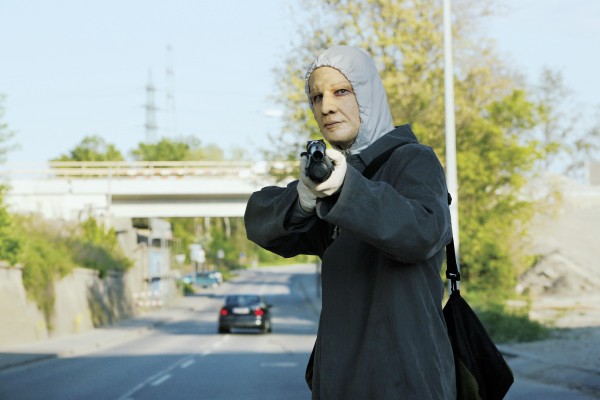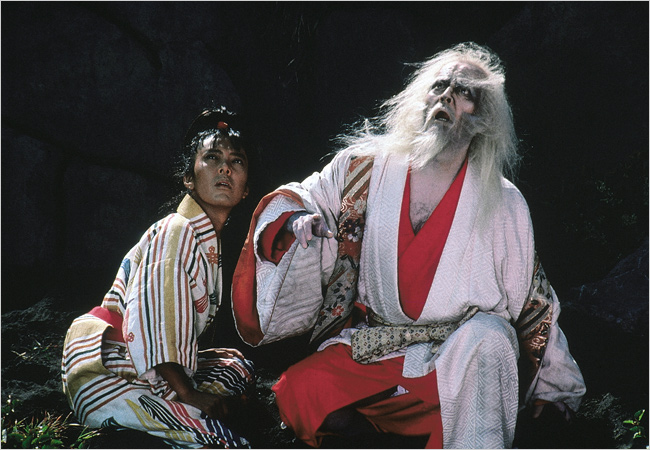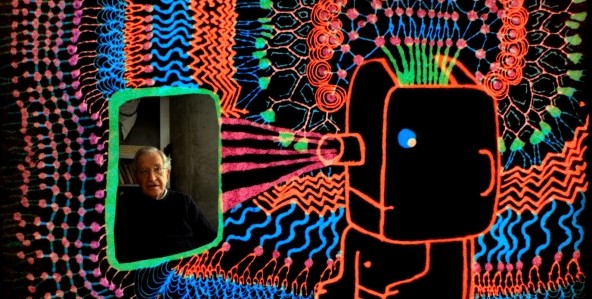NARCO CULTURA (Shaul Schwarz, 2013)
AMC Empire 25
234 West 42nd St. between Seventh & Eighth Aves.
Opens Friday, November 22
212-398-2597
www.narcoculture.com
www.amctheatres.com
 “They say that it’s safe on the other side, that people don’t kill over there. But the narcos are over here,” a young boy says at the beginning of Shaul Schwarz’s startling documentary, Narco Cultura. The child is standing on the Mexican side of the fence that separates one of the most dangerous cities in the world, Juárez, where 3,622 murders occurred in 2010, from the safest in the United States, El Paso, Texas, which had only five murders that same year. In the film, Israeli-born, New York-based photojournalist Schwarz (The Block) examines the exploding narco culture, in which a growing number of men, women, and children in Mexico and America cheer on guns and violence and turn drug lords into heroes. Serving as director and cameraman, Schwarz follows Juárez native Richi Soto, a crime scene investigator who covers his face when on the job to hide his identity, as colleagues keep getting targeted for assassination, and LA-based narcocorrido singer-songwriter Edgar Quintero, who pens individually commissioned tunes for drug cartel members and later performs them with his popular group, BuKnas de Culiacan. While Soto lives in fear, continuing to do his duty even though some ninety-seven percent of murder cases end up not getting investigated by the police, Quintero is famous, appearing at sold-out concerts and starring in quickie films that glorify violence and drug culture. Schwarz, who served in the Israeli Air Force and has covered conflicts in Haiti, the Gaza Strip, and other hot spots around the world, gets right on the front lines, showing horrific scenes of violence while avoiding any talking-head experts, letting the staggering numbers and the rivers of blood speak for themselves, the real-life results of the failed war on drugs.
“They say that it’s safe on the other side, that people don’t kill over there. But the narcos are over here,” a young boy says at the beginning of Shaul Schwarz’s startling documentary, Narco Cultura. The child is standing on the Mexican side of the fence that separates one of the most dangerous cities in the world, Juárez, where 3,622 murders occurred in 2010, from the safest in the United States, El Paso, Texas, which had only five murders that same year. In the film, Israeli-born, New York-based photojournalist Schwarz (The Block) examines the exploding narco culture, in which a growing number of men, women, and children in Mexico and America cheer on guns and violence and turn drug lords into heroes. Serving as director and cameraman, Schwarz follows Juárez native Richi Soto, a crime scene investigator who covers his face when on the job to hide his identity, as colleagues keep getting targeted for assassination, and LA-based narcocorrido singer-songwriter Edgar Quintero, who pens individually commissioned tunes for drug cartel members and later performs them with his popular group, BuKnas de Culiacan. While Soto lives in fear, continuing to do his duty even though some ninety-seven percent of murder cases end up not getting investigated by the police, Quintero is famous, appearing at sold-out concerts and starring in quickie films that glorify violence and drug culture. Schwarz, who served in the Israeli Air Force and has covered conflicts in Haiti, the Gaza Strip, and other hot spots around the world, gets right on the front lines, showing horrific scenes of violence while avoiding any talking-head experts, letting the staggering numbers and the rivers of blood speak for themselves, the real-life results of the failed war on drugs.




 Stanley Kubrick’s harrowing Paths of Glory, based on the novel by Humphrey Cobb, is quite simply the best English-language antiwar film ever made. Kirk Douglas stars as Colonel Dax, a French military man who disagrees with his superiors’ insistence on sending his men into certain annihilation in order to take a worthless hill during World War I. Dax’s verbal battles with Generals Broulard (Adolphe Menjou) and Mireau (George Macready) are unforgettable, as are the final scenes, in which three random men are chosen to pay the price for what the generals call cowardice. Filmed in stunning black and white, Paths of Glory puts you right on the front lines of the folly of war. Kubrick, who wrote the unrelenting script with Calder Willingham and Jim Thompson, also made the best film about the cold war (Dr. Strangelove, or How I Learned to Stop Worrying and Love the Bomb), the Roman slave revolt (Spartacus), and, arguably, the Vietnam War (Full Metal Jacket). One of the most emotional, powerful stories ever put on celluloid, Paths of Glory is screening for free on November 22 at 7:00 as part of the New-York Historical Society’s Bernard and Irene Schwartz Classic Film Series and will be introduced by author Michael Korda (Ike: An American Hero, With Wings Like Eagles: A History of the Battle of Britain) with a focus on “WWI and Its Legacy in Film.”
Stanley Kubrick’s harrowing Paths of Glory, based on the novel by Humphrey Cobb, is quite simply the best English-language antiwar film ever made. Kirk Douglas stars as Colonel Dax, a French military man who disagrees with his superiors’ insistence on sending his men into certain annihilation in order to take a worthless hill during World War I. Dax’s verbal battles with Generals Broulard (Adolphe Menjou) and Mireau (George Macready) are unforgettable, as are the final scenes, in which three random men are chosen to pay the price for what the generals call cowardice. Filmed in stunning black and white, Paths of Glory puts you right on the front lines of the folly of war. Kubrick, who wrote the unrelenting script with Calder Willingham and Jim Thompson, also made the best film about the cold war (Dr. Strangelove, or How I Learned to Stop Worrying and Love the Bomb), the Roman slave revolt (Spartacus), and, arguably, the Vietnam War (Full Metal Jacket). One of the most emotional, powerful stories ever put on celluloid, Paths of Glory is screening for free on November 22 at 7:00 as part of the New-York Historical Society’s Bernard and Irene Schwartz Classic Film Series and will be introduced by author Michael Korda (Ike: An American Hero, With Wings Like Eagles: A History of the Battle of Britain) with a focus on “WWI and Its Legacy in Film.” 


 As it turns out,
As it turns out, 